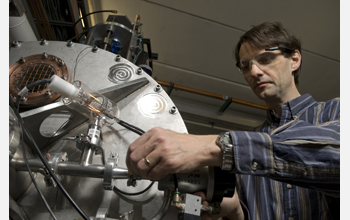Multimedia Gallery
Radio Frequency Fragment Separator
Senior physicist Daniel Bazin adjusts the radio frequency fragment separator at the National Superconducting Cyclotron Laboratory (NSCL) at Michigan State University (MSU). The new equipment, which was supported by the National Science Foundation (NSF), has allowed MSU researchers to make first-of-its-kind measurements of several rare nuclei, one of which has been termed a "holy grail" of experimental nuclear physics. The discoveries, which were made at NSCL using an isotope purification device, will help to refine theoretical models about how elements are created in the cosmos, something that until now has been beyond the technical reach of nearly all of the world's nuclear science facilities.
To learn more, see the MSU news story MSU Researcher Nabs "Doubly Magic" Tin Isotope. (Date of Image: December 2008)
Credit: Greg Kohuth, MSF
Images and other media in the National Science Foundation Multimedia Gallery are available for use in print and electronic material by NSF employees, members of the media, university staff, teachers and the general public. All media in the gallery are intended for personal, educational and nonprofit/non-commercial use only.
Images credited to the National Science Foundation, a federal agency, are in the public domain. The images were created by employees of the United States Government as part of their official duties or prepared by contractors as "works for hire" for NSF. You may freely use NSF-credited images and, at your discretion, credit NSF with a "Courtesy: National Science Foundation" notation.
Additional information about general usage can be found in Conditions.
Also Available:
Download the high-resolution JPG version of the image. (1.1 MB)
Use your mouse to right-click (Mac users may need to Ctrl-click) the link above and choose the option that will save the file or target to your computer.



